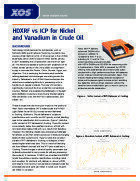Analytical Instrumentation
HDXRF vs ICP for Nickel and Vanadium in Crude Oil
May 04 2018
Author: XOS on behalf of XOS
Technology introduced over the last decade, such as horizontal drilling and hydraulic fracturing, has led to new sources of light tight oil (LTO). LTO has grown in the US from essentially zero in 2010 to about 5 million barrels per day in 2017, exceeding the US production volume of non-tight oil. This trend is expected to continue with projections of 10 million barrels per day in the US by 2025, and significant supply in countries like Russia, China, Canada, Egypt, and Argentina. This is reshaping the landscape of available refining feedstock and challenges are arising across the industry. Refineries in the US Gulf Coast and across the world have invested significantly in processing units to handle much heavier crude oil. The new LTO contains significantly more naphtha than crude from conventional sources. Refiners are experiencing bottlenecks in the light ends distillation capacity and are having trouble keeping their conversion units, like the FCC, hydrocrackers, and cokers, full.
Digital Edition
PIN 25.3 June/July
June 2024
Analytical Instrumentation - Recent Advances In Various Bench Scale Accelerated Oxidative Testing Methods For Fuels - Petrochemical Industry: Anton Paar Solutions Streamline Processes, Reduce H...
View all digital editions
Events
Jul 30 2024 Jakarta, Indonesia
Jul 30 2024 Jakarta, Indonesia
China Energy Summit & Exhibition
Jul 31 2024 Beijing, China
Jul 31 2024 Chengdu, China
Aug 05 2024 Moon Township, PA, USA















